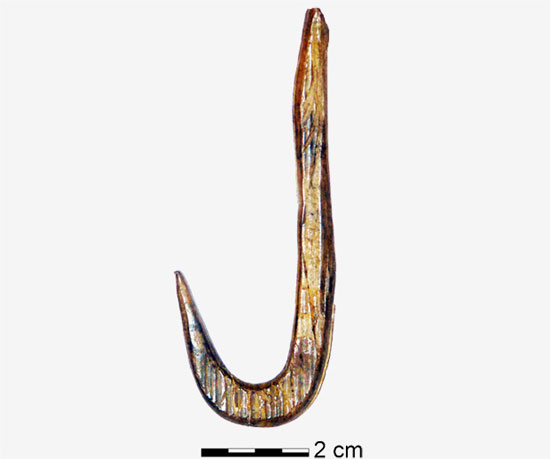Find the set of hooks from the ice age
Archaeologists have found six hooks made of mammoth bones, created and used by the ancient people at the end of the ice age, about 12,300 years ago.
Excavating an archaeological site in Wustermark, Germany, ancient hunters were discovered to leave fishing hooks with bones of mammals and fish. 6 fishing hooks made from mammoth bones show that humans have been fishing for more than 12,300 years ago, in order to capture aquatic life in large lakes in warm climates.

Fish hooks are made from mammoth bones.
Archaeological experts who participated in the excavation said that fish living in lakes in warm climates possessed outstanding swimming ability, making catching with tuberculosis or spears not effective. Meanwhile, previous archaeological documents suggest that humans lived 12,000 years ago, mainly relying on gathering, hunting and fishing in shallow streams.
However, the newly excavated site used to lie on an ancient lake, making traditional fishing unsuitable. For this reason, fishing hooks were created to help catch the fish living in the lake. The bones of animals in the cave, including fish bones, show that these hooks have been effective.
Because mammoths were extinct by the time these residents lived, archaeologists believed that the bones or ivory of an elephant were accidentally found and used throughout the years. Based on the superior hard properties and sharpening of the bone, the ancient people made them the most special hunting tools of the time.
The discovery of the hook makes the scientists absolutely amazed at the sophistication of ancient hunters. Previously, ancient fishing hooks were also discovered in East Timor but in terms of perfection, it was still inferior to 6 newly discovered hooks in Germany. Currently, scientists have not been able to explain the process of the ancient people inventing the hook as well as the exact time this type of tool was put into use.
- Find the world's oldest fishing hook
- Intelligent hooks help shark sharks
- Prehistoric people took fishing techniques in deep waters
- These animals have superhuman abilities
- Butterflies 'vampires' use blood as gifts
- Smart application that helps new students find safe accommodation
- Dog sniffs each other to find food
- Fresh Find software - Search for 9 in 1
- The dead whale belly in the European sea is full of garbage
- Pigeons smell the air to find their way
- True story: Worm species find food thanks to complex mathematical programming
- Finding a soulmate through a mathematical formula will be more lasting than a relationship of love alone
 Discovered an ancient centipede fossil 99 million years old
Discovered an ancient centipede fossil 99 million years old Discovered bat-like dinosaurs in China
Discovered bat-like dinosaurs in China Discovered a 200-year-old bronze cannon of the coast
Discovered a 200-year-old bronze cannon of the coast Discover 305 million-year-old spider fossils
Discover 305 million-year-old spider fossils